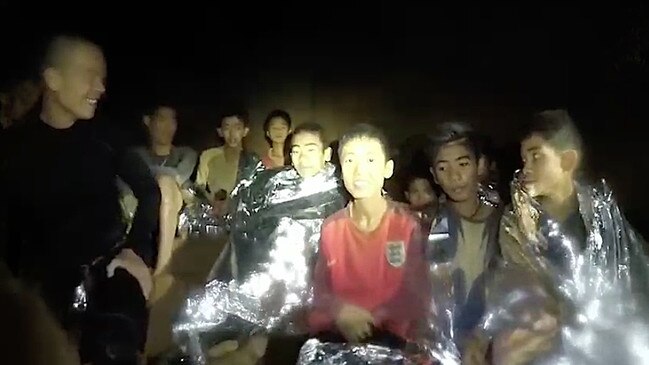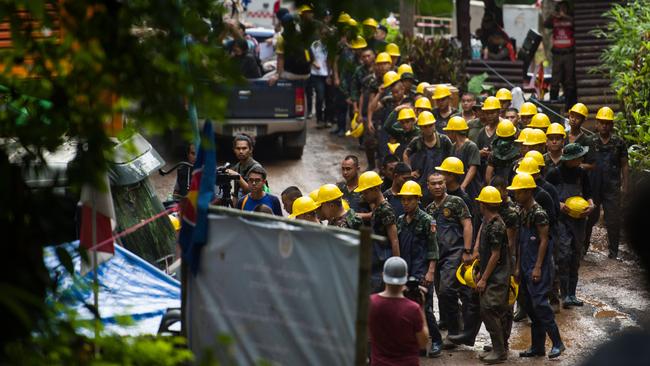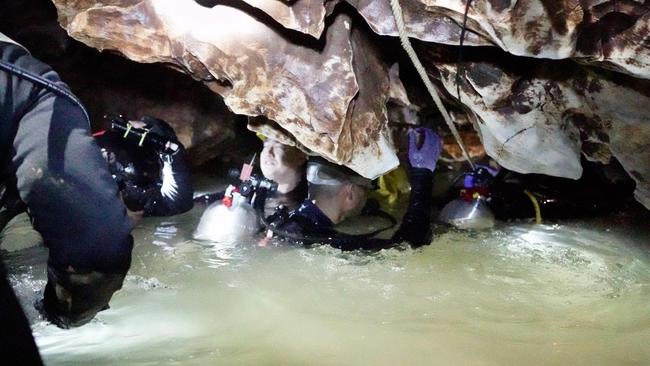Thai cave rescue options between a rock and even harder place
No option is easy when it comes to the rescue of 12 boy footballers and their coach from precarious shelter in a Thai cave.

Somewhere above the precarious subterranean shelter in which 12 boys and their football coach have perched in pitch darkness for 13 days, the occasional faint sound of life has filtered down into the flooded cave — a dog barking, a rooster crowing, even children playing.
It is those sounds that led rescuers yesterday to accelerate the search for a hole or “chimney” in the mountain above the sprawling 10km Tham Luang cave complex that could be expanded to allow the boys to be pulled to safety.

As many as 30 Thai military search teams were scanning the mountaintop yesterday to try to pinpoint exactly where the boys are underground — 3km from the cave mouth and past a number of chambers and narrow canyons, some flooded with water now being pumped from the cave at a rate of 180,000 litres per hour.
Since June 30, engineers have pumped more than 1.3 million litres of water from the cave, emptying aquifers and damning rivers to try to lower the water level enough to allow the boys to at least float, if not walk, to freedom. But with monsoon rains predicted this weekend, time is running out.
If that chimney cannot be found, if the water does not drain quickly enough, there will be no palatable alternative for the Wild Boars — a talented team of young footballers with no swimming ability — but to dive their way through the sharp jaws of narrow chambers filled with stalactites and stalagmites they cannot see in the murky water.

If the rain resumes before the boys have been extricated, the cave could well fill up again, forcing rescuers to evacuate and bringing the effort back to square one.
And so for the past two days the team of boys — aged between 11 and 16 — and their 25-year-old coach have been learning how to navigate one of the most technical and nerve-racking cave dives in the world.
The good news is that the first 1500m from the mouth of the cave to what is known as the third chamber — an area that can fit as many as 60 people — is now walkable after the water level there fell more than 40cm overnight on Wednesday and continued to do so yesterday at a rate of 1cm an hour.
Telecommunications engineers on Wednesday tried to establish a high-speed internet in the third chamber so rescuers could communicate with the outside world. However the connection failed, although the military was still working yesterday to bring in a phone line to the boys after a previous effort failed.
It is the second 1500m — from the third chamber to where the boys are perched — that is so technical and perilous that the Thai Navy SEALs responsible for extricating them say it will take between six and eight hours to chaperone each boy through to that point.
Ruangrit Changkwanyuean, who led the Thai diving contingent of the international rescue effort and first helped the Thai SEALs acclimatise to the difficult conditions inside, told The Australian the biggest challenge for the novice divers would be the distance they must cover underwater.
“From where the boys are to the T-section (a narrow, U-shaped and submerged corridor that leads into the third chamber and must be navigated one diver at a time) is mainly underwater, though some sections have air pockets where they can come up and breathe” thanks to the undulating cave floor, he said.

The problem is there will be the stalactites and stalagmites that cannot be seen in the muddy water, and the children will be swimming with a current that could push them into those rocks.
Divers, including an Australian Federal Police Special Response Team of six, have been fixing guide ropes to the stalagmites along the route, which the boys and their SEAL chaperones will have to use to guide them and slow them down where necessary.
As the water level has slowly receded, about 100m of air pockets have emerged in that second 1500m corridor that will probably be used as points where divers will be stationed to assist.
“That will definitely help,” Mr Rangruit said. “If the boys are getting tired or stressed or panicked they can lift their heads up out of the water and comfortably float.”





To join the conversation, please log in. Don't have an account? Register
Join the conversation, you are commenting as Logout